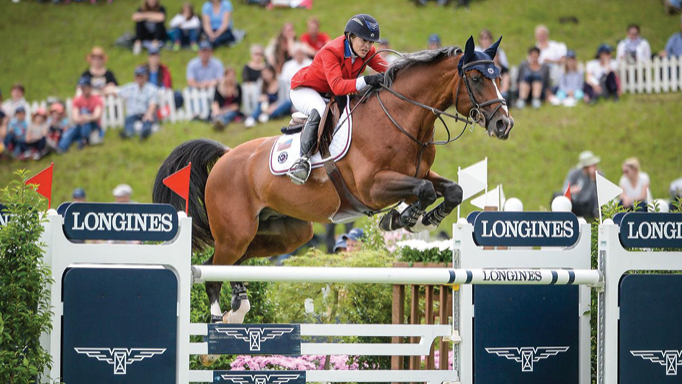Horses, like riders, come in all shapes and sizes. This month’s tips centre on strengthening the smaller riders who are matched with big mounts.
Piloting our beasts around a ring can be daunting with the difference in strength ratio when they decide to exercise their independence. Where our strength and stability comes from in this case is our posterior chain, which includes our spinal erectors, latissimus dorsi (lats), hamstrings, and gluteus maximus (glutes). These muscles help to keep us standing upright against gravity and extended at the hip. They also help us to resist being pulled forward when seated on a horse and able to maintain that elegant yet strong upright seated position. The glute is connected to the opposite lat through the thoraco-lumbar fascia, and this also helps us maintain stability in a twisting motion, for example, maintaining your hips square to your horse while turning your upper body.
The best exercises to strengthen these muscles are the row, front squat, and deadlift. When lifting, form is paramount. If you can’t maintain proper form, back position, etc., then the weight is too heavy and poses a risk for injury and should be taken down a notch.
These exercises should help you sit up tall and effectively against the most feisty mount!
Row

This move is done sitting with your legs straight in front of you, squeezed together. Loop a resistance band around your feet, holding the ends like reins, with arms outstretched. Again, maintain a neutral lumbar lordosis (low back curve), sit up tall with shoulders back. Maintaining that posture, pull the band back to your ribs and slowly release back to the starting position. Tension should be maintained throughout, so if the movement closest to your feet is too easy, shorten your “reins”! Aim for 3 
Front Squat
The front squat is a variant of the more traditional back squat, but the barbell is stabilized across the front of the chest (across collarbones and the front of your shoulder). The literature suggests that this variation creates greater muscle activity in the glute max (compared to deadlifts and back squats), because it requires your glutes to work harder to hold your upper body upright against a weight pulling you forward. This sounds like pretty sport-specific training if you’re trying to stabilize against a horse pulling you forwards in the saddle!
Using a barbell: start with the bar on a rack, a few inches below your collar bones (clavicles) in a standing position. Grip the bar slightly wider than your shoulders. Walk in to the bar so it’s sitting on your clavicles/front of your shoulders, hands supporting it with an open grip and arms parallel to the floor (elbows up and chest up!). Stand up to unrack the bar, and back up. Adjust feet shoulder-width apart with feet very slightly turned out.
Pulling the hips back, sit back into the squat, keeping your bottom close to between your heels. Remember to keep the chest up, elbows high, and knees slightly out.
Once you’ve reached the bottom of the squat, drive through the heels to stand up. To achieve full range of motion in this exercise, you also need full dorsi flexion at your ankles, the same range that lets you get your heels down. Sound familiar? The weight you use should feel heavy, but you should be able to complete 5-6 reps maintaining good posture without feeling like your lower back is losing its natural curve. Complete 5-6 reps x 5.
Dumbbells: The same exercise can be done by using a “clean” movement (lifting two heavy dumbbells from the floor to bring to rest at the front of your shoulders.)
Deadlift

Load the barbell with weight while it’s on the floor. Stand in the middle of the barbell, feet between hip- and shoulder-width position. Set your core and your back muscles and aim to maintain the natural lordosis/curve of your lower back (without overextending). The barbell should be 2-3” in front of your shins.
The deadlift is done by bending over, keeping hips higher than knees in a partial squat position, engaging your glutes, lats, and hamstrings (think ‘squeeze butt, shoulders back and down’), and extending through the hips to lift the bar to a standing position.
From a standing position, maintain muscle contraction and slowly lower the bar back to the ground using your glutes and hamstrings to control against gravity. The bar should follow directly under the shoulders, staying close to the body on the way up and down. Again, complete 5 sets of 5-6 reps at a weight where the last 2-3 are quite challenging, but you can still maintain proper form. The exact same movement can be done with barbells.

